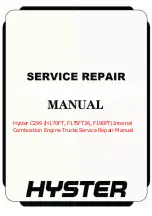
5-4
F-808-R0
Forks
CAUTION
Electrical Fastener Connections
Check for loose electrical connections and frayed or
broken wires.
Hydraulic Cylinders, Fittings & Hoses
Check underneath the truck for evidence of fluid leaks.
Look for hydraulic hose wear, damage and leaks. Make
sure clamps and fittings are tight. If leaks are found, have
service repair all leaks immediately and check the
hydraulic fluid level. Do not drive the truck.
Hydraulic Oil
1.
Lower the mast to within a few inches of the ground,
then tilt it back completely
2.
Side shift the mast to the center (normal carry
position).
3.
With the key switch OFF, turn the steering wheel left
and right until it becomes difficult to turn.
4.
Open the engine compartment by releasing the latch
just under the driver seat in the front of the
compartment.
5.
Open the right side engine door.
6.
Check the fluid level gauge on the right hand side of
the tank.
7.
Clean the area around the hydraulic fill cap, then
open the cap (turn counterclockwise).
IMPORTANT
Do not add Hydraulic oil into the Hydraulic Breather
cap.
It is important that the proper level of oil be
maintained at all times. Failure to check the oil level
as recommended could cause serious mast function
operating problems.
8.
Add hydraulic oil as needed.
9.
DO NOT OVERFILL. With the level above the FULL
line, the oil does not have enough area for expansion
when it heats up during normal operation.
10. If the fluid appears dirty or dark in color, check the
truck’s maintenance log for the last fluid and filter
change and then change accordingly.
11. Install the fill cap, making sure it is tight.
12. Close and latch the access assembly and doors.
Operator Controls
Lift/Lower Control
With the Keyswitch turned ON, raise the mast. The
hydraulic motor should start running as soon as the
control is moved out of the neutral position and stop as
soon as the control returns to the neutral position. The
motor should not run at all when lowering the mast.
Check that the primary mast cylinder extends fully and
that the lift carriage rises to the top of the inner rails
before the secondary cylinders begin to move.
WARNING
When the lift carriage reaches the top of the inner rails
the secondary cylinders and middle rails begin lifting.
Check to make sure the rails travel smoothly and that
there is no chatter or visible binding.
• With the mast fully extended, begin lowering the
mast. The secondary cylinders and middle rails fully
lower first, followed by the primary cylinder and the
lift carriage. Check for smooth travel with no
chattering or visible binding.
• If there is noticeable chatter or binding, immediately
notify your supervisor or service personnel.
• DO NOT attempt to repair the mast or operate the
truck until the problem is corrected.
• Do not service carriage forks while the
Keyswitch is on. If a control lever is
accidentally moved, serious injury could
occur.
• It is recommended to use only Landoll
Corporation replacement parts. Use only
quality forks that are forged or have an up-set
heel and that have the same capacity rating
as the factory installed forks.
• Never use forks repaired by welding.
• Always replace both forks. Switching forks
from one truck to another can be dangerous if
the capacity of the forks is not known.
• Check the forks for cracks, closely at the heel
portion of the forks. Replace the fork if cracks
are found. Never attempt to repair, weld or
alter a fork.
Make sure there is sufficient room above to raise
the mast safely and keep all people clear.
Summary of Contents for Bendi B40i4
Page 2: ......
Page 12: ...1 4 F 808 R0 FORKLIFT SAFETY AND FAMILIARITY Figure 1 2 Decals...
Page 18: ...1 10 F 808 R0 FORKLIFT SAFETY AND FAMILIARITY Table provided for general use NOTES...
Page 24: ...2 6 F 808 R0 RECEIVING AND INSPECTION Table provided for general use NOTES...
Page 54: ...4 16 F 808 R0 OPERATING THE B40I4 FORKLIFT Table provided for general use NOTES...
Page 62: ...5 8 F 808 R0 Figure 5 5 Lubrication Points...
Page 64: ...5 10 F 808 R0 Table provided for general use NOTES...





























